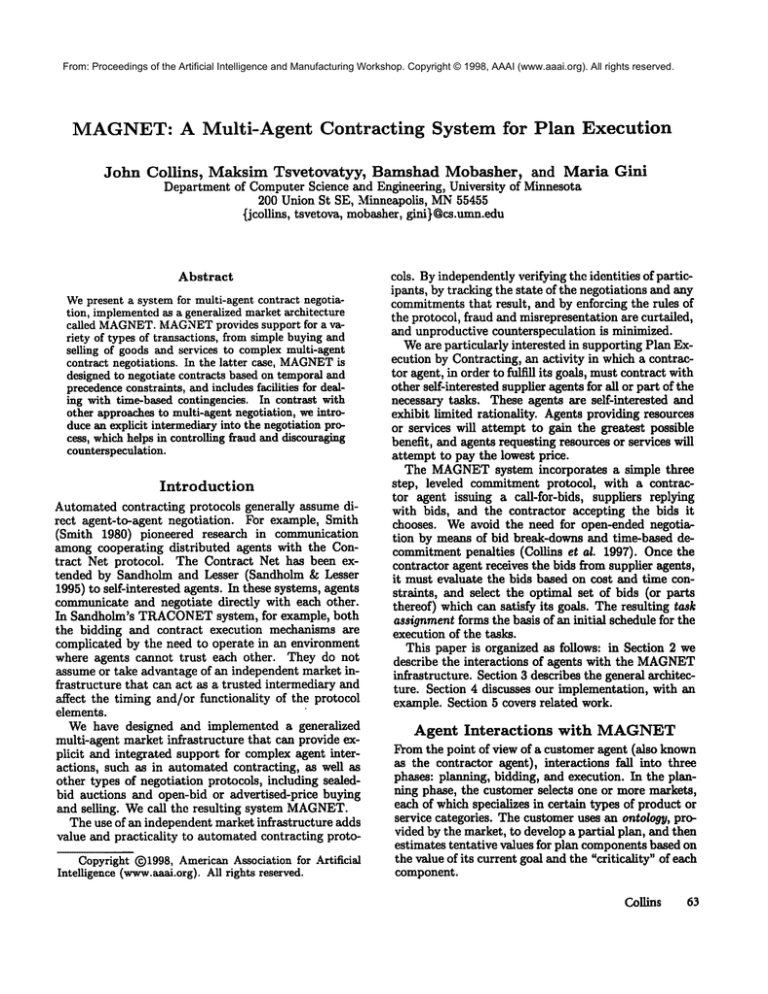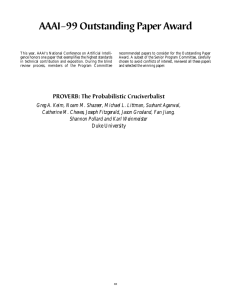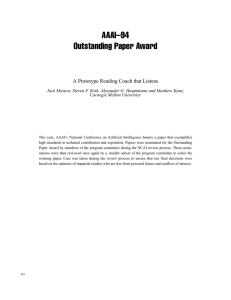
From: Proceedings of the Artificial Intelligence and Manufacturing Workshop. Copyright © 1998, AAAI (www.aaai.org). All rights reserved.
MAGNET: A Multi-Agent
John Collins,
Contracting
Maksim Tsvetovatyy,
System
for
Plan
Execution
Bamshad Mobasher, and Maria Gini
Department of Computer Science and Engineering, University of Minnesota
200 Union St SE, Minneapolis, MN55455
(jcollins, tsveto,~, mobasher, gini)~cs.umn.edu
Abstract
Wepresent a system for multi-agent contract negotiation, implementedas a generalized marketarchitecture
called MAGNET.
MAGNET
provides support for a variety of types of transactions, from simple buying and
selling of goods and services to complexmulti-agent
contract negotiations. In the latter case, MAGNET
is
designed to negotiate contracts based on temporal and
precedenceconstraints, and includes facilities for dealing with time-based contingencies. In contrast with
other approachesto multi-agent negotiation, we introduce an explicit intermediary into the negotiation process, whichhelps in controlling fraud and discouraging
counterspeculation.
Introduction
Automated contracting protocols generally assume direct agent-to-agent negotiation. For example, Smith
(Smith 1980) pioneered research in communication
among cooperating distributed
agents with the Contract Net protocol. The Contract Net has been extended by Sandholm and Lesser (Sandholm & Lesser
1995) to self-interested agents. In these systems, agents
communicate and negotiate directly with each other.
In Sandholm’s TRACONET
system, for example, both
the bidding and contract execution mechanisms are
complicated by the need to operate in an environment
where agents cannot trust each other. They do not
assume or take advantage of an independent market infrastructure that can act as a trusted intermediary and
affect the timing and/or functionality of the protocol
elements.
We have designed and implemented a generalized
multi-agent market infrastructure that can provide explicit and integrated support for complex agent interactions, such as in automated contracting, as well as
other types of negotiation protocols, including sealedbid auctions and open-bid or advertised-price buying
and selling. Wecall the resulting system MAGNET.
The use of an independent market infrastructure adds
value and practicality to automated contracting protoCopyright ~)1998, AmericanAssociation for Artificial
Intelligence (www.aaai.org).All rights reserved.
cols.
By independently
verifying
theidentities
ofparticipants,
by tracking
thestateofthenegotiations
andany
commitments
thatresult,
andby enforcing
therulesof
theprotocol,
fraudandmisrepresentation
arecurtailed,
andunproductive
counterspeculation
is minimized.
We axeparticularly
interested
in supporting
PlanExecution
by Contracting,
an activity
in whicha contractoragent,
inorder
tofulfill
itsgoals,
mustcontract
with
other
self-interested
supplier
agents
forallorpartofthe
necessary
tasks.Theseagentsareself-interested
and
exhibit
limited
rationality.
Agentsproviding
resources
or services
willattempt
to gainthegreatest
possible
benefit,
andagents
requesting
resources
orservices
will
attempt
to paythelowestprice.
The MAGNETsystemincorporatesa simplethree
step,leveledcommitment
protocol,
witha contractoragentissuing
a call-for-bids,
suppliers
replying
withbids,and the contractor
accepting
the bidsit
chooses.We avoidthe needfor open-ended
negotiationby meansof bidbreak-downs
andtime-based
decommitment
penalties
(Collins
et al.1997).Oncethe
contractor
agentreceives
thebidsfromsupplier
agents,
it mustevaluate
thebidsbasedon costandtimeconstraints,
andselecttheoptimal
setof bids(orparts
thereof)
whichcansatisfy
itsgoals.
Theresulting
task
assignment
formsthebasisof aninitial
schedule
forthe
execution
of thetasks.
Thispaperis organized
as follows:
in Section
2 we
describetheinteractions
of agentswiththe MAGNET
infrastructure.
Section
3 describes
thegeneral
architecture.Section
4 discusses
ourimplementation,
withan
example.
Section
5 coversrelated
work.
Agent Interactions
with MAGNET
From the point of view of a customer agent (also known
as the contractor agent), interactions fall into three
phases: planning, bidding, and execution. In the planning phase, the customer selects one or more markets,
each of which specializes in certain types of product or
service categories. The customer uses an ontology, provided by the market, to develop a partial plan, and then
estimates tentative values for plan componentsbased on
the value of its current goal and the "criticality" of each
component.
Collins
63
From: Proceedings of the Artificial Intelligence and Manufacturing Workshop. Copyright © 1998, AAAI (www.aaai.org). All rights reserved.
Once a plan is developed, the customer initiates a
session in the market to encapsulate the bidding and
execution activities related to meeting its goal. The interactions involved in the basic bidding and execution
cycle among the contractor, supplier, and market session are illustrated in Figure 1. A detailed description
of this protocol can be found in (Jamison 1997). During
the execution phase, the interactions can be muchmore
complexthan indicated here, since either party maydecommit from a contract (and pay a penalty), and the
contractor is continuously monitoring and repairing its
plan by replanning and rebidding when events fall to
proceed according to expectations. Finally, the customer and suppliers finalize financial settlements and
the session is terminated.
-- !!..+:
T
Figure 2: The Structure of an Exchange
Markets. Each Market within an exchange is a forum for commerce in a particular commodity or business area. There would be markets devoted to banking,
publishing and printing, construction, transportation,
industrial equipment, etc. Each market includes a set
of domain-specific services and facilities,
as shownin
Figure 3, and each market draws upon the common
services of the exchange.
lFigure 3: The Structure
change
Figure 1: A Typical Session-Mediated Negotiation
The MAGNET Architecture
The MAGNET
architecture is a distributed set of objects that can support electronic commercein a variety
of domains, from the simple buying and selling of goods
to situations that require complex multi-agent negotiation and contracting.
The fundamental elements of
this architecture are the exchange, the market, and the
market session, as outlined below.
The Exchange. An Exchange is a collection
of
domain-specific markets in which goods and services are
traded, along with some generic services required by all
markets, such as verifying identities of participants in a
transaction, or a Better Business Bureau that can provide information about the reliability of agents based
on past performance. Architecturally, an exchange is a
network-accessible resource that supports a set of markets and commonservices, as depicted in Figure 2.
64
AIMW-98
of a Market within the Ex-
An important component of each market is a set of
current Market Sessions in which the actual agent interactions occur. Agents participating in a market may
do so as either session initiators, or as clients, or both.
As detailed in the next section, each session is initiated by a single agent for a particular purpose, and in
general multiple agents mayjoin an existing session as
clients. Important elements of the market include:
¯ An Ontology that is specific to the domain of the
market, specifying the terms of discourse within that
domain. In a commodity-oriented domain, it would
include terms for the products or services within the
domain, as well as terminology for quality, quantity,
features, terms and conditions of business, etc. In
a planning-oriented domain, specifications of services
would be in a form that supports planning.
¯ A Protocol Specification that formalizes the types of
negotiation supported within the market. Within
a planning-oriented market domain, these specifications would be limits on parameters of the negotiation protocol, such as the maximumdecommitment
From: Proceedings of the Artificial Intelligence and Manufacturing Workshop. Copyright © 1998, AAAI (www.aaai.org). All rights reserved.
protocol,
whether
bidscanbe awarded
beforethebid
deadline,
etc.
¯ A Registry
of marketclients
whohaveexpressed
interestin doingbusiness
in themarket.Entriesin
thisregistry
wouldinclude
theidentity
of a client,
a
catalog
(ora method
foraccessing
a catalog)
of that
client’s
interests,
products
orcapabilities,
whichcan
beusedto locate
clients
tomeetrequests
fornewsessionparticipants,
anda clientagentthatis empoweredto negotiate
contracts
on behalf
of thesupplier.
Client
catalogs
arerequired
toexpress
theirinterests
andofferings
in termsof themarket’s
ontology.
Figure 4: The Structure of a Market Session
persistently stores the current state of the session from
the standpoint of the client. Proxies are market entities that act on behalf of the agents and enforce market
rules.
There are two reasons for the existence of the proxy
components. The first is related to security: client
proxy components cannot see the private data of the
initiator or of other clients. The second is that in a distributed system environment, the processing and persistent data elements of the initiator and clients would
presumably be at different locations in the network to
maximize performance.
MarketSessions.A Market Session(or simply
session)
is thevehiclethrough
whichmarketservices
aredelivered
dynamically
to participating
agents.
It
serves
as an encapsulation
fora transaction
in themarket,as wellas a persistent
repository
forthecurrent
stateof thetransaction.
We havechosenthe term"session"
to emphasize
the
temporally
extended
natureof manyof theseinteractions.Forexample,
in a construction-oriented
market,
if an agentwishesto builda newhouse,it initiates
a
session
andissues
a call-for-bids.
Thesession
extends
fromtheinitial
call-for-bids
through
thenegotiation,
Implementation
awards,construction
work,payingof bills,andfinal
closing.
Inotherwords,
thesession
encloses
thefulllife
The MAGNET
system is implemented in Java and conof a contract
(orpossibly
a setof related
contracts). sists of the MAGNET
server and a client API, which
Thesession
mechanism
ensures
continuity
of partially- enables developers to create client software suited to
their needs. MAGNET
currently includes several client
completed
transactions,
protects
against
fraudby verifying
theidentity
of agents,
limits
counterspeculationpackages implementing this API, including a GUI-based
byenforcing
negotiation
rules,
andrelieves
theparticend user system and automated test clients for testing
ipatingagentsfromhavingto keeptrackof detailed
of the protocol.
negotiation
statusthemselves.
The current MAGNET
market implementation
is
Agentscanplaytwodifferent
roleswithrespect
to
built as a distributed Java server application, using Java
anysession.
Theagentwhoinitiates
a session
is known
RMIas the communication mechanism, and an object
database to provide persistence. The core of the server
asthesession initiator, whileother
participating
agents
areknownas session
clients.
A session
canbe initiated is a singleton Exchange object and three Homeintereitherforthepurpose
of buyingor selling,
depending faces, one for Markets, one for Sessions, and one for
on thetypeof market.
In theaboveexample
of building Participants.
Each Homeprovides factory and finder
a house,
theinitiating
agentwasthebuyeror customer, capabilities for its respective collection. The Exchange
andtheotherparticipants
wouldbe sellers
or suppliers, is the only interface registered with the network namwhether
theyweresupplying
materials,
labor,advice,
ing service; everything else is accessed through the Excredit,
orotherservices.
A session
couldalsobe initichange.
atedtosellitemsor services
at auction.
Figure 5 is a simplified UMLdiagram of the server
At anygiventime,a session
canbe opento newparcomponents. The customer and supplier proxy compoticipants,
or closed.
A public
auction
wouldtypically
be
nents that appear as part of the Session in the abstract
opento newparticipants,
whilethehouse-building
sesarchitecture have been separated out and consolidated
siondescribed
abovewouldbe closedoncethecontracts as the Participant. Each registered Agent has a Particwerelet.Themarketmaintains
a listof opensessions
ipant object in the server’s database. The Participant
whichmay be accessed
by participating
agents.
will be active whenever an Agent is actively logged in
Figure4 showsthe structureof a session.Two
to the server, and wheneverany Session that it particiAPIsareexposed,
oneforthesession
initiator
andone
pates in needs to send data to it. Using the Participant
forsession
clients.
Eachsession
contains
an Initiator in this way allows Agents to disconnect from the server
Proxythatimplements
the Initiator
API and persiseven when it has active Sessions, without risk of data
tentlystoresthecurrent
stateof thesession
fromthe
loss.
standpoint
of theinitiator.
The Session and the Participant,
as well as the
A ClientProxyis provided
foreachclientthatsimAgentInterface on the client side, are subclasses of
ilarlyprovides
a ClientAPI to theclientagent,and
EventListener. This class supports the receipt of protoCollins
65
From: Proceedings of the Artificial Intelligence and Manufacturing Workshop. Copyright © 1998, AAAI (www.aaai.org). All rights reserved.
|indPa~cil~nt
Iogin
loglnNew
0
i notify
cuslom~login
In
e
I
suppllerSeuiane
r logout
tex’t
addCulltornorSelmion
~pplmrsjoinSes,~on
___.J ;
ship 1000 shrink-wrap packages, including media, manuals, license forms, registration cards, and license key
stickers. The old method would be to find a broker or
publisher, and hand over the job.
Nowassume Acmehas an intelligent
agent that can
act as a broker in the Exchange. The manager gives
the goal to her automated agent, which enters the exchangeto assemblea set of contracts to satisfy the goals.
Wewill assume the agent is already registered with the
exchange. The agent searches the exchange and finds
two markets that provide services to satisfy its goals.
One deals with services for software publishing - printing services, digital media, and one with packaging and
shipping (Figure 6)
i!"............II
TruckandOontldnor
idllpl:ing, Nr
FmloI¢Overseas
Fmlg~
actlvateSeWon
deactlvateSeuion
getSessionContext
Figure 5: Exchange components
col events. Eachsubclass treats these events differently,
as appropriate for its function.
The Session enforces the protocol rules, and maintains its internal state according to the protocol activity and the passage of time. For example, once the
initial CallForBids has arrived, the Session will accept
Bids, and once the BidDeadline passes, the Session will
no longer accept Bids. The Participant receives events
from the Agent, and checks security and optionally decrypts them before forwarding them to the Session. The
Session interprets the messages and records them, possibly setting timeouts and updating its state, them forwards them to the appropriate Participants.
The Participant then forwards them to its Agent just in case the
Agent has activated that Session. This allows an Agent
to start up multiple Sessions, and use its Participant
to filter events to just the ones it is interested in at the
moment. This is important for bandwidth management
as well as to allow the Agent to control its allocation of
computational resources.
The system is designed to be protocol-neutral. Only
the Session and the Agent need to interpret messages,
and the Agent specifies the protocol to be used when
it initiates the Session. The initial prototype includes
a version of the protocol outlined earlier implemented
as a set of Java classes, and a KQML
version is in the
works.
Example
We now describe the implementation using an exaraple. A startup company, Acme Software and Screen
Doors, Inc., is releasing vcrsion 1.0 of its newkiller application. The product manager, who is also the president and chief programmer, has a goal: produce and
66
AIMW-98
Figure 6: Markets for Software Publishers
Using operators obtained from the ontologies in the
selected markets, the agent formulates a plan to satisfy
its goals. Its plan looks like Figure 7, and is entered
into the Magnetclient using an interface that consists
of a Gantt chart and a property sheet for entering and
editing task parameters (Figure 8)
I
,
Print boxes !
,
~
I
[Generate
%\ //
,o.,.,
I Pdnt
.£
¯
cards
I
I "~nt
license
I _S_~j
Lfo,.m, ]
Figure 7: Plan for Release 1.0 Production
Next, the agent establishes the necessary credit with
exchange, as specified by the chosen markets, and requests contract negotiation sessions in all 3 markets.
The plan is now broken down by market, and the agent
submits a call-for-bids to each session. It is acceptable
if the submitted subplans overlap. This is becanse some
From: Proceedings of the Artificial Intelligence and Manufacturing Workshop. Copyright © 1998, AAAI (www.aaai.org). All rights reserved.
whether to risk starting plan execution on the assumption that a supplier for the stickers can be found before
plan execution reaches the point where they are needed.
8- ~meeo’e#mmdknmDom..~e,,~ I I
-- OmoqllOCD~
It decides (or is told by our manager) that the stickers
, -- RWHCCe
Media
can be done in-house.
ml ..
dL~"
.’_:....
.~:~.:~,:,~".::.::::..:::..:.7..:.:.:.~::~..:::::.*..:::.:.’~’..;::::~::Z.
The customer agent now awards the selected bids,
~-~..
:~,.~::~~.~,~::
:..-::.
...................
.~--~.m=,
.--~,.
~,--,~*.
..............................
::::::::::::::::::
,.a ==,=]PrintBoxes ~:,:::,:::,
and workcommences.
Partway throughthe process,
the
box
printer
backs
out,
andpaystherequired
decomi.~iii
~~::::
I
mitmentpenalty.
Our agentre-opens
biddingfor box
printing,
receives
andawardsa bid.Thecustomer
agent
¯ ii1
monitors
taskprogress,
posting
payments
as agreedat
taskor taskcompletion.
Oncealltransactions
arecom¯ .-:. ....................................................:.
pleted,
thecustomer
agentrequests
therespective
mar===========================================================================
kets
to
terminate
the
sessions.
¯.::::,
~.::i~
i i:~]~’;]::::::~::~::~::.::.::.;.;::::::~i~::~::~::~::~;:;¯
....::::...:.:.:.:.:.:.:.........:.:::::i:i.;.
i
¯" . i
Related Work
To the extent that we require the existence of an ex................................................................................................................
;.::.:.:.:~.::.~...
::~:i~:.:::i ternal market mechanism as an intermediary, our proi[i[i[i[i[i[i:.::.[.iiiiii[i[i[iii[i[i[i[i]i~:~j~.~.;::i::::..-:.i::
....... ....:.:.,i:i:i::i:i:i
............
::.i.i.[i[i[i::i:.:.!
posed frameworkis similar to that of Wellman’smarketoriented programming used in AuctionBot (Wurman,
...............................................................
.J]
WeUman,& Walsh 1998). AuctionBot supports a variety of auction types each imposing a set of market
Figure 8: Customer Creates a Plan of Action
rules on the agent interactions. Hence, the auctions,
themselves, becomethe intermediaries. The entity that
sets up the auction can specify certain parameters for
potential contractors may give lower bids on combinathe auctions. In contrast, our framework provides extions of multiple tasks than they would on single tasks.
plicit market mechanisms which can not only specify
Figure 9 shows the customer agent in the process of
and enforce auction parameters, but also support more
setting timing parameters for its call-for-bids.
complex interactions such as automated contracting in
a variety of types of markets based on a market ontology. Furthermore, these market mechanisms also enforce general market rules and "social laws", such as
government regulations, by which all participants must
abide.
Rosenschein and Zlotkin (Rosenschein & Zlotkin
BidOeadllnn
BidDeadline
di4ennlnns
b’MIIron
1994) analyze a variety of domains and propose a claswhen
bidding
will be closed
~
.
a
sification of problems into domains that are characterElrlllld Offer Dm
ized by different types of negotiation amongagents.
EldlOM
ofrer Datedgennlnee
when
bidding
openlfo~yourItems
They show that the behavior of multiple, interacting
~ ..
=l
agents can be influenced by the set of rules (the proEerlie¢ConndlllUon
Tlrne
EarliestConsldnmUon
Titan
tocol) that the system designers choose for the agents’
determines
when
youamallowedto
seeHtebide,Thinlib useful
for
environment. The purpose of these rules is to allow the
~
..
I
g
sealed-bid
IUcUOrll
agents to make constructive agreements. Their analysis
i
assumes that the negotiating agents have similar capabilities. The protocol we present in this paper does not
require that assumption.
Figure 9: Customer Issues a Call-for-Bids
Mechanisms to reduce counterspeculation,
such as
the Clarke tax mechanism (Ephrati & Rosenschein
Eachsessionnowinvitespotential
contractors
who
1996) or the Vickrey auction (Vickrey 1961) have been
haveexpressed
interest,
through
themarket
registry,
in
proposed for automated negotiation of self-interested
thesubject
matterof thebids,to jointhesessions
as
agents. The architecture we present can support the
clients.
Someof thosecontractors
submitbids.
Vickrey auction, and eliminates one of its limitations
Thecustomer
agentreceives
thebids,andattempts
by providing a structure that can act as a trusted aucto assemblethemintoan optimalfeasibleplan.Untioneer (Sandholm 1996).
fortunately,
no supplier
hasbidon printing
thelicense
A variety of architectures have been proposed for sinkey stickers.
At thispoint,thecustomer
agentmust
gle and multiple agents in different domains (see, for
decidewhether
itsownresources
cansatisfy
thisneed,
instance, (Eriksson & Finne 1997; Kinny & Georgeff
whether
the plancansucceedwithout
thestickers,
or
1997; Lejter & Dean 1996; Rodriguez et al. 1997)).
,: CallForBids
Collins
57
From:MAGMA
Proceedings
of the Artificial
andan
Manufacturing
Workshop. Copyright
© 1998,
reserved.
(Tsvetovatyy
et Intelligence
al. 1997),
openarchitecEphrati,
E.,AAAI
and(www.aaai.org).
Roscnschein, AllJ.rights
1996.
Deriving
tureforagentsinterested
in buyingandselling,
supportsbothmanualand automatednegotiation
witha
limitedformof Vickreyauction.EventhoughMAGMA
already
includes
manyof thefeatures
of thearchitecturewe presenthere,MAGMAis intendedfor a more
limiteddomain.An earlierversionof the systemwe
describe
hereisoutlined
in(Collins
etal.1998).
Substantial
workis underwayin standardizing
an
openarchitecture
for electronic
commerce(Tennenbaum,Chowdhry,& Hughes1997; McConnellet al.
1997).Ourarchitecture
improves
on theseproposals
by
addingsupport
formorecomplex
negotiation
protocols.
Forexample,
ourarchitecture
couldbe implemented
by
cxtendingthe frameworkpresentedin (Tenncnbanm:
Chowdhry,& Hughes1997).
Conclusions
and Future
Work
In this paper we have brought together ideas from recent work in market architectures for electronic commerce, and work in multi-agent contracting protocols.
Wehave presented a generalized market architecture
that provides support for a variety of transaction types,
from simple buying and selling to complex multi-agent
contract negotiations. Wehave also presented a protocol that takes advantage of the services of the market.
Our market architecture is organized around three basic
components: the exchange, the market, and the session.
Wehave shown how the existence of an appropriate
market infrastructure
can add value to a multi-agent
contracting protocol by controlling fraud and discouraging counterspeculation.
Wehave begun implementing software-agents to interact within MAGNET,
and intend to benchmark their
performance against humanparticipants as well as each
other. Weare exploring how modifying the paramcters
of the market and session protocols affects the performance of the system. Eventually, we would like to open
our testbed to outside participation over the Internet.
This work raises several interesting questions for future research. A game-theoretic analysis of the protocol
could be done to determine optimal strategies for its use
by agents. In particular, how should the decommitment
penalties be used, and how should proposed decommitment functions be evaluated when computing marginal
costs of plan alternatives.
The methods for composition of possibly overlapping bids into feasible or even
optimal plans must be worked out.
References
Collins,
J.; Jamison,
S.;Gini,M.;andMobasher,
B.
1997.Temporal
strategies
in a multi-agent
contracting
protocol. In AAAI-g7 Workshop on AI in Electrvnic
Commerce.
Collins, J.; Youngdahl, B.; Jamison, S.; lVIobasher,
B.; and Gini, M. 1998. A market architecture
for
multi-agent contracting. In Second Int’l Conf on Autonomous Agents, 285-292.
68
AIMW-98
consensus in multiagent systems. Artificial Intelligence
87:21-74.
Eriksson, J., and Finne, N. 1997. Marketspace: an
open agent-based market infrastructure. Master’s thesis, ComputingScience Dept., Uppsala University.
Jamison, S. 1997. A negotiation protocol and market agent model for complextransactions in electronic
commerce. Technical Report TR97-037, University of
Minnesota, Dept of Computer Science and Engineering.
Kinny, D., and Georgeff, M. 1997. Modeling and design of multi-agent systems. In J.P. Mller, M. W.,
and Jennings, N., eds., Intelligent Agents lII, Lecture
Notes in Artificial Intelligence. Berlin: Springer.
Lejter, M., and Dean, T. 1996. A framework for the
development of multi-agent architectures.
IEEE Expert.
McConnell, S.; Merz, M.; Maesano, L.; and Witthaut,
/vI. 1997. An open architecture for electronic commerce. Technical report, Object ManagementGroup,
Cambridge, MA.
Rodriguez, J. A.; Noriega, F.; Sierra, C.; and Padget,
J. 1997. FlVI96.5 - a Jaffa-based electronic auction
house. In Second Int’l Conf on The Practical Application of Intelligent Agents and Multi-Agent Technology
(PAAM’gT).
Rosenschein, J. S., and Zlotkin, G. 1994. Rules of
Encounter. Cambridge, MA: MIT Press.
Sandholm, T., and Lesser, V. 1995. Issues in automated negotiation and electronic commerce: Extending the contract net framework. In 1st International
Conf. on Multiagent Systems, 328-335.
Sandholm, T. W. 1996. Limitations of the Vickrey
auction in computational multiagent systems. In Second Int’l Con/on Multi-Agent Systems.
Smith, R. G. 1980. The contract net protocol: High
level communicationand control in a distributed problem solver. IEEE Trans. on Computers 29(12):11041113.
Tennenbauin, J. M.; Chowdhry, T. S.; and Hughes,
K. 1997. eCo System: CommerceNet’s architectural
framework for internet commerce. Technical report,
Object Management Group, Cambridge, MA.
Tsvetovatyy, M.; Gini, M.; Mobasher, B.; and Wieckowski, Z. 1997. MAGMA:
An agent-based virtual
market for electronic commerce. Journal of Applied
Artificial Intelligence (6).
Vickrey, W. 1961. Counterspeculation, auctions, and
competitive sealed tenders. Journal of Finance 16:837.
Wurman, P.; Welhnan, M.; and Walsh, W. 1998. The
Michigan Internet Auctionbot: A configurable auction
server for humanand software agents. In Second Int’l
Con]. on Autonomous Agents, 301-308.






